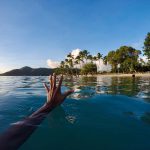This is a non-gay story.
Unusual Route–Unexpected Cruise
The voyage happened by accident because of a casual stop at an information kiosk. 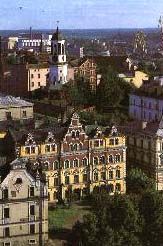 (The Finns love to promote their country’s wonders with copious tourist kiosks and hundreds of brochures.) We found a pamphlet detailing the delights and happenings in the old city of Lappeenranta, two hundred miles northeast of Helsinki. The information also described a trip called “Overnight to Russia on the Saimaa Canal”. We had never heard of Lappeenranta, Vyborg or the watery link between the two.
(The Finns love to promote their country’s wonders with copious tourist kiosks and hundreds of brochures.) We found a pamphlet detailing the delights and happenings in the old city of Lappeenranta, two hundred miles northeast of Helsinki. The information also described a trip called “Overnight to Russia on the Saimaa Canal”. We had never heard of Lappeenranta, Vyborg or the watery link between the two.
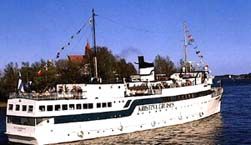 We looked at each other and knew we wanted to go. But the fine print said at least three-day advanced reservation was recommended, and the last cruise of the season sailed last week! Undaunted, we called the cruise line office from a hundred miles away.
We looked at each other and knew we wanted to go. But the fine print said at least three-day advanced reservation was recommended, and the last cruise of the season sailed last week! Undaunted, we called the cruise line office from a hundred miles away.
Yes, they had stopped for the winter, but another shipping company sailed year round. Another quick call on our Tel-Fin phone card netted us the good news that there was one cabin available–for tonight’s sailing. Needless to say it was a quick drive across Finland’s scenic backcountry.
On Board History
Four hours later we were on board the ms Kristina Praha, a gracious old ship built in Chicago for war in 1943 as a submarine destroyer. After American war action off the coast of Africa and later in the service of the British in Gibraltar, the vessel was sold to Norway and fitted as a pleasure cruiser. Now, with us on board during an unusually balmy Finnish September evening, the old gal was gliding down Finland’s longest canal on daily tours like an elderly docent guiding visitors through a museum of natural history.
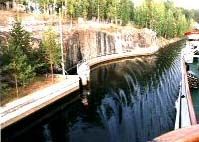 Smoothly and silently through the Finnish wilderness we glided with not single car or truck in sight. The overnight ferry sliced southward headed for Russia, through eleven locks cut into solid rock–without visas and sans souci (without worry).
Smoothly and silently through the Finnish wilderness we glided with not single car or truck in sight. The overnight ferry sliced southward headed for Russia, through eleven locks cut into solid rock–without visas and sans souci (without worry).
Kristina Cruises offer the trip, which transports merry-making tourists (Finns in search of cheap beer) from the city of Lappeenranta, far upstream in Finland, to the seaport of Vyborg Russia. This great trench was dug a hundred years ago to give Lappeenranta and other inland towns, connected by lakes, access to the North Sea.
As it turned out, history was as much a part of this trip as the scenery and the international changes. Not merely a gentle float through the precision locks and several lakes, the journey transported us from the prosperity, cleanliness and tidy efficiency of Finland, downhill to the dismally neglected Russian City of Vyborg.
It was indeed a passage back in time. Once the second largest city in Finland, Vyborg was taken away by Russia along with a big chunk of the surrounding wilderness of Karelia. The action was part of a revengeful reparations agreement with Finland in 1943 as punishment for Finland’s misguided alliance with the German aggressors.
Along the Canal
On board, our little cabin was fitted with two bunk beds, a closet size bathroom including a hand held shower, and one starboard porthole locked shut with four heavy brass knobs. We promptly opened it to bring in the soft warm air of this September evening. (Departure was seven p.m., arriving in Vyborg early the next morning.)
The blue-and-white vessel had retained her aged period look, fortunately, despite numerous cosmetic improvements over the years. Near the captain’s bridge, the elegant and cozy ‘Viipuri Kabinetti’ (Vyborg Cabin) was a sitting room with wood veneered walls, scarlet crushed velvet seats and burgundy tablecloths. It resembled the aged comfort of the Orient Express.
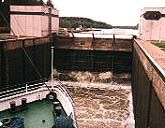 The nine-hour journey took us through each narrow lock, which cradled us between two thirty-foot walls of dark, water-stained concrete and rock. As giant hydraulic doors closed behind us, the Finnish operator in his modern, glassed-in control room (the Finns have a lease to run the locks), pressed the buttons that opened the watergate ahead of us. Water rushed in to fill the lock and raise the Praha to the next level–about twenty-five feet per lock. There are eleven locks which elevate vessels about a three hundred feet up from sea level at Vyborg and into the countryside a distance of about thirty-five miles.
The nine-hour journey took us through each narrow lock, which cradled us between two thirty-foot walls of dark, water-stained concrete and rock. As giant hydraulic doors closed behind us, the Finnish operator in his modern, glassed-in control room (the Finns have a lease to run the locks), pressed the buttons that opened the watergate ahead of us. Water rushed in to fill the lock and raise the Praha to the next level–about twenty-five feet per lock. There are eleven locks which elevate vessels about a three hundred feet up from sea level at Vyborg and into the countryside a distance of about thirty-five miles.
Halfway along the canal is the first Russian lock, guarded by a soldier watching silently as ships glide by carrying prosperous tourists from Scandinavia. Not far away the steel skeleton of a guard tower protrudes above the lovely forests just breaking into their autumn chromatic mutations. An invisible line marks the boundary between these two very different cultures, but those differences were indeed visible once we entered Russian territory. The first sign was a dilapidated old Lada (Russian made) car that someone had hand painted red. Perhaps it belonged to the underpaid guard.
Arriving in Vyborg
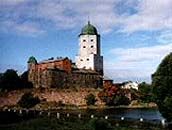 The lifestyle in Vyborg is not just mileage away from Finland. It is also an emotional, intellectual, and cultural satisfaction distance as well. The Soviet Empire bequeathed its citizens a rusted infrastructure and faulty economy. The tattered community of Vyborg is typical of many rural Russian cities rendered sallow and faltering by the failures of that regime. Because of its close proximity, this particular metropolis stands in poignant contrast with the cheerful, efficient and prosperous world of Scandinavia.
The lifestyle in Vyborg is not just mileage away from Finland. It is also an emotional, intellectual, and cultural satisfaction distance as well. The Soviet Empire bequeathed its citizens a rusted infrastructure and faulty economy. The tattered community of Vyborg is typical of many rural Russian cities rendered sallow and faltering by the failures of that regime. Because of its close proximity, this particular metropolis stands in poignant contrast with the cheerful, efficient and prosperous world of Scandinavia.
The best site in town is the ancient and photogenic castle (started in 1293) that proudly overlooks the anemic harbor. It has been kept in reasonably good repair, perhaps for tourist revenue or as a tenuous monument to historic pride. But the other classic buildings and many business venues in Vyborg are a sad and maddening legacy of inhumane and inept governance. Along the sidewalks, the paucity was reflected in the cheerless faces as workers and shoppers went about their routines.
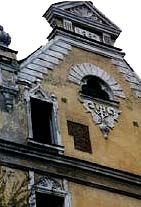 The parks were unkempt; weeds grew around the anonymous occasional statuary; old communist-built vehicles whined and sputtered along the patchwork of asphalt and cobblestone streets. I saw perhaps only half a dozen newer SUV’s running about. Big new transport trucks from Scandinavia rumbled along the edge of town toward St Petersburg sixty miles to the east. The local trucks were old, gutsy and lethargic.
The parks were unkempt; weeds grew around the anonymous occasional statuary; old communist-built vehicles whined and sputtered along the patchwork of asphalt and cobblestone streets. I saw perhaps only half a dozen newer SUV’s running about. Big new transport trucks from Scandinavia rumbled along the edge of town toward St Petersburg sixty miles to the east. The local trucks were old, gutsy and lethargic.
Once-beautiful and ornate neo-classic facades were missing windows or crumbling from lack of care and restoration.
We ventured into a grocery market whose sparse and paltry appearance seemed much like a scene from an old Foreign Legion movie in a third world. Meager selections of fruit, meat, dry goods, canned foods, fruits and vegetables were displayed on bare wooden shelves or in old scratched glass cases. The dim cavernous interior was very much in need of paint and bright lighting. The floor was bare cement.
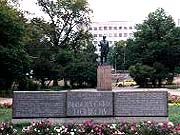 Even the newer tourist Hotel Druzhba looked grim with its tawdry Soviet design and poor upkeep. Inside this laughably four star hotel, the entry floor was ugly black terrazzo stone, the sheer curtains sagged and the vinyl seating was clearly not designed for ergonomic lounging.
Even the newer tourist Hotel Druzhba looked grim with its tawdry Soviet design and poor upkeep. Inside this laughably four star hotel, the entry floor was ugly black terrazzo stone, the sheer curtains sagged and the vinyl seating was clearly not designed for ergonomic lounging.
The sad train station stood in limp condition; its high vaulting ceilings were peeling paint and grime had acquired over decades. Old diesel trains lumbered to a stop a few times a day. Pitiful kiosks were illuminated with only a single fluorescent shedding light on the cheap trinkets and unappealing snacks. No post cards. A makeshift newsstand of cardboard was set up on flimsy crates and displayed a few newspapers and magazines, none in English or Finnish. But there was chewing gum and beef jerky at one counter.
In the Marketplace
The Market Square was the liveliest place in town, located next to the big market hall. Inside, local farmers thwacked and sawed butchered meat, placing the bloody flesh on un-refrigerated marble slabs. Scraggly vegetables, vines of sausage, and freshly baked bread (the most affordable product) were also for sale from overweight ‘babushka’ women with scarves wrapped around their heads.
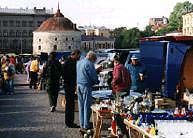 Outside in the open market were dry goods being sold at stalls or out of car trunks. Glassware, babushka dolls, pirated CD’s, used and new clothing, old souvenirs (lots of Lenin busts), and old Soviet uniforms. We saw one vendor offering some vintage record players, circa 1030’s. Vodka is always for sale and cheap beer is popular with the Finns who buy the stuff by the case, or six cases, then trot them away on little luggage carts back to the boat.
Outside in the open market were dry goods being sold at stalls or out of car trunks. Glassware, babushka dolls, pirated CD’s, used and new clothing, old souvenirs (lots of Lenin busts), and old Soviet uniforms. We saw one vendor offering some vintage record players, circa 1030’s. Vodka is always for sale and cheap beer is popular with the Finns who buy the stuff by the case, or six cases, then trot them away on little luggage carts back to the boat.
Just off the square, alone and skittish, a little waif about ten years old skulked around looking for whatever might come his way. A smoking cigarette hung out of his mouth as he scurried away when he saw me watching him.
Later, we saw students in old schools, restive, energetic, and probably oblivious to the their living conditions, having never having been to the ‘other side’. They were the liveliest and most cheerful locals we saw that day. It’s not easy for a Russian to emigrate to Finland; such is the strong contrast between the two countries that an illegal immigrant would quickly be noticed.
Escaping the Sadness
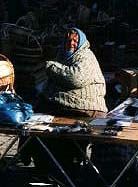 Our own passage away from this sad city was secured by our magic-carpet passports that whisked us past the drudgery, tatters and shab of Vyborg so populated by the rag-wrapped hawkers of old Russia. I confess I felt secretly relieved yet simultaneously guilty knowing how easy it was for me to pass back into the comfort and convenience of Finland’s tidy farms and towns.
Our own passage away from this sad city was secured by our magic-carpet passports that whisked us past the drudgery, tatters and shab of Vyborg so populated by the rag-wrapped hawkers of old Russia. I confess I felt secretly relieved yet simultaneously guilty knowing how easy it was for me to pass back into the comfort and convenience of Finland’s tidy farms and towns.
Upon entry and exit we had to count out all our money in front of the Russian immigration police. It was not hard to imagine their thoughts as they watched the day tourists shuffle through hundreds of dollars with seemingly blithe indifference to the doleful hardships here.
A few hours later we crossed that imaginary boundary between the two countries, gliding back upstream among countless white birches and clover-lined canal edges. How easy the passage was for those with the luck to have the right documents.
That distinction caused me to pause and consider the imaginary attitudes and belief systems that bring countries into conflict or peace. This same turf and waterway were under bloody siege a mere sixty years ago as young men dropped dead in defense or offense over these same forests. Now, the conifers and larch stand peacefully by the water flowing downstream through the colors of all four seasons, generation after generation.
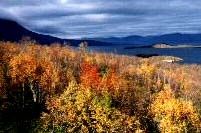 Meanwhile, on board, in the quiet wood-lined dining room of our ship, fitted out with linen table cloths and wine glasses, most passengers headed back to the dance bar after dinner for more folksy entertainment. I preferred the soft quiescence of this forward room, gazing at the passage of the foliage, the cultures and lulled security of time. I thought about how this serene canal had been cut through the surrounding wilderness. Finland has well over a hundred thousand lakes which were also carved out a few hundred thousand Pleistocene years earlier, before there were such things as territorial wars.
Meanwhile, on board, in the quiet wood-lined dining room of our ship, fitted out with linen table cloths and wine glasses, most passengers headed back to the dance bar after dinner for more folksy entertainment. I preferred the soft quiescence of this forward room, gazing at the passage of the foliage, the cultures and lulled security of time. I thought about how this serene canal had been cut through the surrounding wilderness. Finland has well over a hundred thousand lakes which were also carved out a few hundred thousand Pleistocene years earlier, before there were such things as territorial wars.
Touring modern and ancient history in one boat, in one day: it was not hard to imagine.
Also see:
Gay Russia Stories
Gay Russia News & Reports 2000 to present


